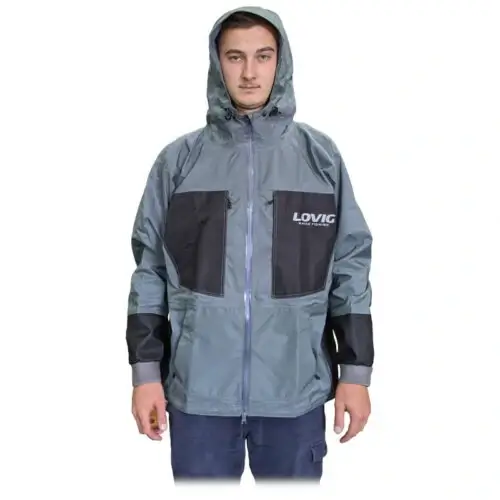
Wind and waterproof breathable fabrics (such as Gore-Tex and the like) as used in Lovig Waterproof Apparel as well as most outdoor recreational garments are high performance technical materials that will perform better and last longer with a bit of care and attention. This is the case with Lovig Waterproof Pants & Jackets.
About Water Repellency
There are two degrees of water proofing in most technical fabrics. The secondary waterproofing is provided by a breathable membrane that is laminated between the outer and inner layers. Proper care and maintenance should ensure optimal performance and longevity of the membrane. The primary water repellency is provided by what is known as a Durable Water Repellent (DWR) that is coated upon the outer layer. This is what causes the water to bead off the fabric.
High performance waterproof / breathable fabrics perform optimally when the DWR is intact. Time, usage and excessive washing and use of detergents can and eventually will wear it out. When this occurs the fabric will ‘wet out’ and while this won’t effect the performance of the inner membrane it will effect permeability; even though the inner fabric will remain waterproof, its ability to remove perspiration will be diminished significantly.
This will make the fabric feel wet to the touch from the inside and might leave the impression that it is no longer waterproof. What is actually happening is that the water vapour (perspiration) is condensing back into liquid when it hits a wet face fabric. This can create the impression of leakage even when it isn’t.
Restoring DWR
DWR can be reapplied from time to time when required and there’s a couple of ways to go about doing this. If the fabric hasn’t seen excess usage and wear and tear, you might be able to reactivate the DWR by applying heat. One method that often works is to tumble dry on a low to medium heat level. Alternatively (and especially if your garment is not machine washable) you can use an iron to apply heat (warm setting, no steam). If you do this it is highly advisable to use a towel between the iron and fabric to avoid potential damage
The best way to restore DWR repellency on technical fabrics is to use a spray-on or wash-in DWR restorer. These can be purchased from outdoor recreation stores. Be sure to follow usage instructions closely for best results. Brands to look out for include Grangers, Nikwax & Gear Aid. Be sure to clean the garment before applying a DWR treatment.
Washing Instructions
After use it is highly recommended to rinse down the garment with warm water to remove any salt, sand, dirt or mud and hang to dry and air out afterwards. From time to time you will need to wash your garment but do this sparingly – avoid putting them in with a load of regular washing, long washing cycles and excessive use of detergents. Less is more!
Hand or machine washing wash in warm water on short cycles. We do not recommend the use of powdered soaps or any soaps containing additives such as fabric softeners, conditioners, stain removers or bleach, as the chemicals can effect the breathability of the waterproof membrane. Drip dry or tumble dry briefly on medium heat.
Repairing holes or damaged seams
As kayak anglers, we’re working with hooks, knives and other sharp & pointy things. As such, it’s altogether possible to puncture the fabric inadvertently. Don’t fret – holes or tears can be easily repaired using a seam sealing adhesive (commonly used for repairing tents and tarps). It is equally effective at repairing seams that may have formed a leak (usually caused by excessive washing, particularly if washed and or rinsed in hot water). We recommend McNetts Aquaseal, but any good seam-sealing glue (as sold by outdoor recreation stores)
